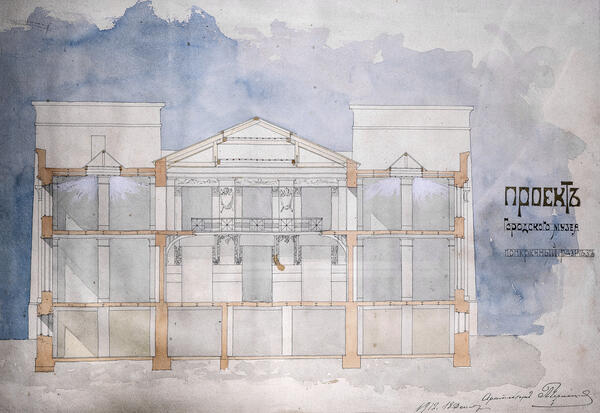The Krasnoyarsk City Museum (now the Krasnoyarsk Regional Museum of Local History) was opened in 1889 and for the first 40 years was located in the house of the Krutovskys’, the house of the Svetlakovs’ and in the building of Gostiny Dvor. By 1912 the museum’s collections had grown four times and it was decided to build a separate building.
The design of the museum in the Egyptian style was proposed by the leading Krasnoyarsk architect Leonid Chernyshev. He based it on his completed project of a scientific pavilion for the First West Siberian Agricultural, Forestry, Trade and Industrial Exhibition, which was held a year earlier in Omsk.
Chernyshev was inspired by the examples of ancient Egyptian architecture when creating the design of the museum. One of the prototypes of the city museum building was the Temple of Isis on the island of Philae in Aswan, built around 350 BC. The main and rear facades of the museum are stylized as a pylon — a tower-like structure, a traditional element of the entrance to an ancient Egyptian temple.
The architect planned to have a vast hall for 400 people in the center of the museum, similar to the columned halls of ancient Egyptian temples. The adjoining rooms on the second and third floors were intended for museum exhibitions. On the basement floor there were storerooms for collections, a library, an archive, a laboratory, workrooms, and a room for central heating devices.
The cost of the building together with internal equipment and furniture was estimated at 90,000 rubles. The construction of the museum started in the spring of 1914, but the work was interrupted due to the outbreak of the First World War. The museum building without interior decoration was used as a barracks for troops and later as an infirmary for typhus patients. The Krasnoyarsk Regional Museum of Local Lore moved to a new building only in 1930.
In January 1929, the People’s Commissar of
Education of the USSR Anatoly Lunacharsky visited Krasnoyarsk and left
ambiguous impressions about the new building of the museum in his article
“Siberia Coming to Life” in the newspaper “Evening Moscow”:




